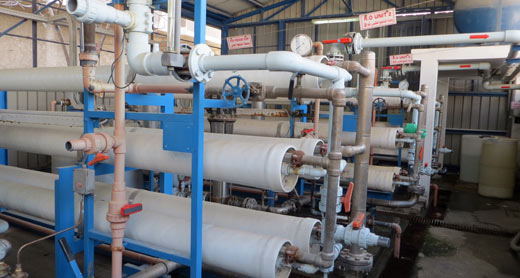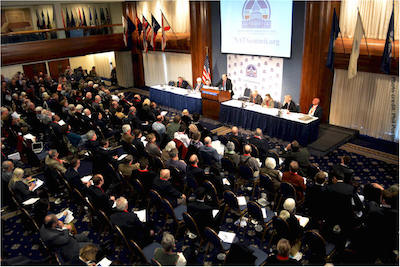Over 90% of water in Gaza Strip unfit for drinking
Feb 9 2014 / 6:12 pm
B’Tselem, 2/9/14 – Gaza’s main water source is the coastal aquifer, which is also used by Israel and Egypt. It has been continuously over-pumped for decades, even prior to Israel’s occupation in 1967. At present, the Palestinian Water Authority pumps some 180 million cubic meters (mcm) a year from the aquifer in Gaza, although its replenishment rate is only 50-60 mcm a year. Over the years, this has significantly lowered the groundwater level, leading to contamination of the aquifer’s water by seawater seeping in and saline groundwater rising from deeper in the reservoir. Israel currently sells Gaza 4.2 mcm of water a year and has agreed to sell another 5 mcm of desalinated water annually, but the infrastructure work for conveying the water have yet to be completed.
Another longstanding problem in the Gaza Strip is the lack of proper wastewater treatment. Many residents are not even connected to a sewage system, and domestic waste flows into cesspits, from where it seeps into the groundwater and contaminates it. The problem has grown worse in recent years, primarily due to electricity shortages. In addition, Israel damaged wastewater-treatment facilities during Operation Cast Lead, resulting in far greater quantities of sewage going untreated. Although the facility has since been restored and new infrastructure laid in towns previously not connected to a sewage system, Gaza’s wastewater-treatment facilities are far from able to meet the required amounts and standards.
Although infrastructure has since been rebuilt or added in towns previously left untreated, Gaza’s wastewater-treatment facilities are far from meeting the necessary standards. Various projects to improve infrastructure are slow to progress, due both to Israel’s restrictions on importing construction materials and equipment into Gaza as well as to lengthy bureaucratic processes in the international organizations funding the projects.
>The Palestinian Water Authority in Gaza has found a rise in nitrate levels in the water due to contamination, mostly caused by pesticide use in agriculture and sewage seeping into the aquifer. Every day, only some 25 percent of Gaza’s wastewater – about 30,000 cubic meters – is treated and recycled for agricultural use. Some 90,000 cubic meters of untreated or partially treated wastewater flows daily into the Mediterranean, resulting in contamination, health hazards and damage to the fishing industry. Due to the increased nitrate levels, the aquifer is now high in nitrogen and chloride, rendering 90 to 95 percent of its water unfit for drinking and problematic for agricultural use. The PA’s Water Authority also found that only 14 wells (some 6.5% of all wells in Gaza) provide water that meets World Health Organization standards.
Ninety-seven percent of Gazans are connected to the public water-supply system, yet this does not ensure a steady supply of water, as the Gaza Strip suffers from shortages of water, shortages in the electricity needed to pipe water through the system, as well as from severe problems with infrastructure. Consequently, residents suffer deliberate water outages, receiving running water for only six to eight hours at a time: 25% of households on a daily basis, 40% every other day, 20% once every three days, and the remaining 15% (in Gaza City, Rafah and Jabaliya) only one day out of four.
The erratic supply of water forces residents to collect water in containers. These containers are placed on rooftops, yet power outages often mean that the pumps that are to channel the water into the containers are out of commission, forcing residents to collect water in other container, on ground level.
Wafa al-Faran, 42, a married mother of eight, lives in a-Shuja’iya neighborhood, Gaza City. She related the following testimony to B’Tselem:
The power outages really interfere with the water supply to our houses. When there’s no electricity, there’s very little water in the taps. We had to buy a pump so that the water would reach the containers on our roof. We have four containers of 4,000 liters altogether. When we get running water, we turn the pump on and fill up the containers. But sometimes, there’s no electricity when there’s water. When that happened, we used to operate the pump with a generator, so that we wouldn’t run out of water. But the generator uses a lot of fuel, which is very expensive. Now there’s no fuel from Egypt and the fuel from Israel is very expensive, so we don’t use the generator at all. Even at night, when we don’t have power, we make do with candles and flashlights. A few months ago, my husband bought a new water container, which we put at the entrance to the house, so that we can fill it up when there’s no power. We get water out of the container in buckets, because it’s not connected to our plumbing.
We don’t drink the water that from the pipes and don’t use it for making coffee or tea or for cooking. We buy fresh water from water vendors. Sometimes, I use the fresh water to wash my daughters’ hair, and in the morning we use this water to wash our faces, because the water from the taps burns our eyes.
Average water consumption in the Gaza Strip is 70-90 liters per person, per day, while the minimum recommended by the World Health Organization is 100 liters per person, per day. Although most residents in Gaza are connected to the public water system, the water’s poor quality means they must buy water treated in governmental or private factories, or factories operated by charities.

Khan Yunis Water Authority wastewater treatment facility. Photo by Muhammad Sabah, B’Tselem, 4 February 2014
Ibtesam Kheir a-Din, 48, a married mother of six lives in a-Sultan neighborhood, Rafah. She related the following testimony to B’Tselem:
The water we get is salty and unfit for drinking. Sometimes it even smells bad. We use it only to clean the house and do dishes and laundry, but nothing ever feels really clean. The clothes sometimes smell bad and get stained. The water also ruins the washing machine. We’ve fixed the machine several times, which cost us 50 to 70 shekels [approx. 14 USD – 20USD] every time, and the technician said the problems were caused by the too many salts in the water. We don’t drink the water or use it for cooking. For cooking and drinking, we buy water every day from vendors who go around the neighborhood or from shops that sell water containers. We buy 50 liters of fresh water a day, at two shekels [approx. 0.6 USD] a liter. Lately, because power outages have gone on for as long as twelve hours at time and because we don’t have enough money to pay for fuel to run the generator to fill the containers, we’ve started buying water for dishwashing and laundry, too.
On 1 November 2013, Gaza’s power plant was shut down due to a fuel shortage, and the sewage pumping stations had to be run on generators. On 13 November, one of the stations in a-Zaytun neighborhood, Gaza City, stopped operating due to a generator malfunction, causing some 35,000 mcm of raw sewage to flood the neighborhood and leak into homes.
Fat’hi Saqer, a 67-year-old resident of the neighborhood, told B’Tselem:
I live with my wife and seven children, who are five to seventeen years old, on the ground floor of a building, about twenty meters away from the sewage pumping station. On Wednesday, 13 November 2013, at around 1 o’clock, we’d just finished eating lunch after the boys came back from school, when suddenly sewage started leaking into our house. We started taking off the floor the mattresses and rugs and clothes that got wet. Then we tried to plug up the drain holes in the house with bits of cloth so that the sewage wouldn’t rise, but that didn’t help. Sewage came up through the holes and filled the house. We stopped up the holes again and started hauling out the dirty water. We put bags of sand up against the front door so that the sewage wouldn’t get in from there. We got completely wet: our hands, feet, our clothing. Everything stank. It took us hours to get all the water out and the floor dry. Then we washed only our hands and feet, because we didn’t want to use a lot of water, in case it would cause another flooding.
As far back as 2009, UNEP recommended that underground pumping from the coastal aquifer in the Gaza Strip cease, in order to prevent collapse of the Gaza water economy. Yet over-pumping continues, in part due to the lack of alternative water sources in Gaza. At present, no plan for a long-term solution to the Gaza water crisis is being implemented. The Palestinian Water Authority and UNEP have cautioned that the coastal aquifer has passed the point of no return in terms of rehabilitation options, so that as of 2016 it will no longer be possible to pump water from the aquifer.
To resolve the grave water crisis in the Gaza Strip, UNEP recommended that all parties to the coastal aquifer – Israel, the Palestinian Authority, the Hamas government and Egypt – act in conjunction to halt the swift rapid deterioration of the groundwater system that serves Gaza and also to work on finding other sources of potable drinking water for its residents. At the same time, and without delay, Israel must allow materials and equipment to be brought into Gaza for the purpose of restoring and developing Gaza’s water and wastewater treatment systems.
• All testimonies gathered by Muhammad Sabah, B’Tselem’s field researcher in the Gaza Strip..

